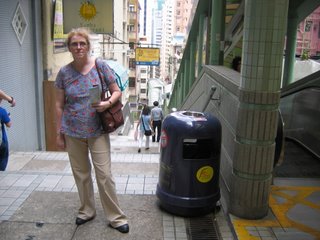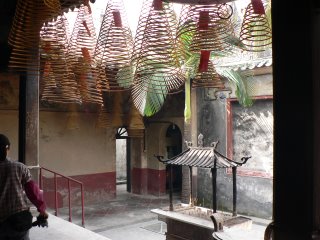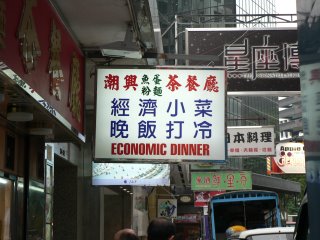Heading to Kerala
We have a long weekend coming up so Marty and I are headed to Kerala for the weekend. We are flying into Cochin and taking a houseboat tour around Alleppy. We will also do some touring in Cochin, and will be back in Chennai on Monday night.
Feeding the Spirit

A couple of weeks ago, someone inquired what I liked most about India. When asked by someone who genuinely wants to know (versus a polite question from a complete stranger at a social gathering or in a business setting), this is a tough question. You want to be able to give an answer that is honest but not too superficial or general, e.g "people are friendly", "I can get health care for my dad and buy prescriptions at a fraction of the cost of the U.S" , "I like not having to do household chores" etc. I have been here long enough now, as well, that I feel I should have a well-thought out and sensitive reply to such a question.
Although there are many things I might point to (see below), I think what I would put at the top is the deep spirituality that you feel and observe in this country, at least in South India which is where I spend most of my time. The daily practices of the people around me reinforce this---from the tilak on foreheads that come in different shapes and colors depending on one's religious customs and beliefs within Hinduism, to rangoli that graces the entrances to homes and businesses, to moon and other fast days observed by the devout, to the ubiquitous silk/cotton thread bracelets that show visits to a particular temple or observance of family ceremonies, such as the one that ties brothers and sisters (rakhi), to reliance on astrology and other esoterica to make important life decisions. Almost every day, you are conscious of the way that things beyond the material and the mundane are part of the fabric of people's lives. In some areas, such as dietary practices, there are parallels in this culture/religion of action to Judaism that I find oddly comforting especially so far from home.
Of course, India is the world's center of yoga, meditation, and other healing arts such as Ayurveda so the spiritual bent is hardly surprising. Every day you see advertisements for courses for all ages---it is very much part of the daily scene. Though I haven't yet taken any classes in yoga or meditation here (except for a couple of quick Sun Salutations every morning, I ironically do less of this here than in the States), I definitely want to before I leave. Two that I'm most interested in are Art of Living and Vipassana. Both can be done in the U.S. as well (see Prince Roy's upcoming review of his experience of the latter), but I'd like to experience one or both while here if at all possible.
If I were to draw up a more comprehensive list of what I like, here are some other things (some related to the spiritual aspect, some not) that I would mention:
1. The respect shown to the elderly, especially by medical personnel
2. The sense of social consciousness of many in the middle class to "give back to society"--Marty sees it in abundance at the Rotary, and I also see it at work
3. Bright and colorful clothing --some of the most beautiful I've seen
4. Beautiful sites--temples in particular
5. The antiquity of many places---this is something appreciated by Americans perhaps more than others
6. The way poverty is always in your face---although I don't like it and it makes me sad, it also forces me to think on a daily basis about how fortunate I am ---and that I'm on the planet to make a difference
7. Affordable, competent medicine
8. Slower pace of life (at least in the South)
9. Great opportunities to see nature ---some of the best wildlife and natural settings in the world.
10. Discovering what isn't different--especially when it comes to people
A Week in Hong Kong

Marty and I just spent a week in Hong Kong. It was my first visit since December 1981, and needless to say, lots had changed. We stayed at the Bishop Lei International House on the Hong Kong side---Frommer's recommendation to take a harbor side suite (US$ 167) was right on the money---very inexpensive by Hong Kong standards. It turned out to be one of the most spectacular views in the city (see above), with floor to ceiling windows in the tiny bedroom that made you feel like you were part of the landscape (not a great picture to the right with the camera flash, but gives you the idea), and a nice sized sitting room besides.
 Although the Bishop Lei is very unpretentious and doesn't have the fancy lobbies and on- the -water location of some of the 5 star hotels, it was also near the Jewish Community center and only a five minute walk from the escalator to Central Hong Kong, which is lined with restaurants, bars, and shops.
Although the Bishop Lei is very unpretentious and doesn't have the fancy lobbies and on- the -water location of some of the 5 star hotels, it was also near the Jewish Community center and only a five minute walk from the escalator to Central Hong Kong, which is lined with restaurants, bars, and shops. The escalator was new since my last visit. Built in 1994, it connects the Central business district of Hong Kong with the residential areas midway to Victoria Peak, and runs down the hill from 8-10 in the morning and up thereafter. It's quite a trip, and brought back memories of another trip to Hong Kong in the late 1970s, when I was living in Japan. My friend Barbara, a classmate at Yale, was in Hong Kong with her parents---her father was stationed there with his employer---and they lived (as I recall) about halfway up the Peak. I don't remember how we got around then, but the escalator sure makes the midlevels, as this area is called, very accessible.

One of the things you must do while in Hong Kong is take the tram to the Peak---a steep ride indeed. There is also a wonderful walk around the Peak that takes about an hour, and gives you breathtaking views. Marty passed on this due to his fear of heights, and from the drop below to the harbor you can see why.
On Wednesday night we went to a community seder sponsored by the Jewish Community Center. It was very enjoyable. Most of the Jewish community in Hong Kong are expats, but there are two synagogues, both located on the same street, and there is also a kosher "emporium" where you can buy wine, kosher meats, etc. We sat at a table with two expat families and a visiting professor and his wife from the Wharton School, and found many common interests. The professor, who travels to Hong Kong several times a year, introduced us to his tailor in Kowloon, where Marty subsequently had a suit made that fits him perfectly. Good Hong Kong tailors are no longer cheap, but the fit and selection and quality of fabric more than makes up for it. There are also a lot of Indian tailors now around Hong Kong---they employ hawkers on the streets, and their prices tend to be cheaper, but we chose to go with a first hand recommendation.
Hong Kong is also no longer the place to buy electronics, at least not cameras, and we narrowly missed being taken in by a common scam. Marty, the King of Costco, asked at just about every camera shop for the price of the Lumix FX01, which is the digital model he has his eye on and had seen at Costco for US$299. Only one shop could beat the Costco price, and said they could do it for $220. We were seated and the guy demonstrated the camera and took our money (I had a funny feeling about the place, and insisted to Marty that we pay cash) while his associate went to get a new, boxed model. He then proceeded to tear down the features of the chosen model, and demonstrate other, higher priced ones. The associate came back and said he didn't have that model on site, he would have to get it from the warehouse---only a few minutes. More hard selling ensued. By this time I started looking at my watch. When the guy told us "40 more minutes for the Lumix FX01, but I can sell you this one right now (a higher priced model)" we bailed and got our money back. I'm just glad that the store didn't get one of our credit card numbers.
Early in our stay, we also went to Macau, about an hour jetfoil ride from Hong Kong. Macau was formerly a Portugeuse colony, and also turned back to China in 1999. Twenty seven years ago when Barbara and I went there it was a rather sleepy place that seemed a poor second cousin to Hong Kong. Now, it is the Las Vegas of the East. Major casinos like the Sands and the Venetian have sprung up (the Venetian is due to open later this year), and they are packed with Chinese tourists, most of them from the mainland. But the casinos were too rich for our blood. For blackjack, which Marty likes, you could find a few tables at the hotels where the minimum bet was HK$100 (about $13). For most, it was HK$200. The tables were packed and most were betting much more. Outside the Sands, we walked by a number of dejected looking people who had obviously gambled and lost. We heard that it is not uncommon for people to save up for months and then come and blow it all in a day (or a few hours).
One of the sites of Macau is the Kun Iam temple (Buddhist), site of the famous stone table where Caleb Cushing, Envoy Extraordinairy and Minister Plenipotentiary (apparently what the U.S. then lacked in clout it made up for in lengthy titles) signed the first treaty between China and the United States in 1844. But the table was inaccessible during our visit due to repair work. Below you can see an inner view of the temple, with the ubiquitous incense coils hanging from the ceiling.

Finally, just like India, Hong Kong is the home of some pretty unusual English. Two examples that we saw during our stay are depicted below.....
Going to Hong Kong
Marty and I are off to Hong Kong for a week. We will attend a Passover Seder at the Jewish Community Center there, and do some sightseeing including Macau.
I haven't been to Hong Kong for nearly 25 years (I stopped there on a reverse around the world trip from Japan to the U.S. in 1981) and am looking forward to returning. My favorite memories are of the Peninsula Hotel humidor (where you can sniff the best quality cigars in the world) and the famous stone table in Macau where a treaty of friendship was signed between the U.S. and China on July 3, 1844. Will do a post when we return next weekend.
In the meantime, holiday greetings......Happy New Year and Vishu, Chag Sameach, and Happy Easter!
Recruiting
One thing you do a lot in a country with a growing economy is interview--both for new and replacement positions. Attrition tends to be high here, with only a few companies able to keep it in single digits. This is not all bad, because it does make it relatively easy to shed non-performers, and it's a common practice that the first six months of employment are conditional---people must be "confirmed" at that point to remain on the rolls. But it also means that both HR and operations people spend a lot of time recruiting and training new people. In fact, when interviewing HR candidates, they usually tell you right away how many positions they filled on their last job.
The first hurdle to overcome in hiring is resumes ("rezooms", as it is pronounced here) or C.V.s. They come in the thousands and for large employers like the IT companies and BPOs, in the tens of thousands. It's not only volume. Resumes here resemble college papers---the average is 5 or 6 pages, and I've even seen one that was 16 pages. (Since many candidates have under 5 years experience, this is not a good omen for the eyesight of future recruiters.) In many cases, you find the contents merely a litany of everything the person claims to have done on prior jobs, and a telephonic screening will often produce some holes--some of them gaping. References can be equally suspect---on one occasion, we found that the applicant included a speaker he had met at a conference.... An HR person at an IT company here recently told me that to deal with the volume and lack of focus in the C.V.s they were getting, they tried to introduce a web site where candidates would have to fill in their experience and qualifications using an online form that would help the company do key word searches to screen for people meeting their specifications. But, most candidates simply refused to use the site and kept sending their 5-20 page C.Vs directly. So now, the company hires a third party to key them in.
Although most candidates will have a lot of experience interviewing, this doesn't mean they are good at it. Although there are obviously those who interview very well, the most common thing I've observed on the negative side are people who just can't stop talking---and who have to be asked repeatedly to answer the question asked and not go off on tangents. (Sometimes getting a word in edgewise to do this redirect can be a challenge. ) The other thing I notice is a tendency to lack self-insight, or to come across as overconfident. A particularly difficult question for many candidates is "if you had one thing to do over in your career, what would it be?" Interestingly, when pushed to the wall on this question, they sometimes say they would not have changed jobs so frequently!
Attrition comes from the luxury of having a booming economy where new companies and jobs are constantly popping up, but it's also due to the nature of jobs themselves, and the expectations of a young workforce. It's not unusual to see a person who has had 3-4 jobs in five years (of course, for many positions, those resumes don't make it past the screening stage here any more than they would in a mature economy). At lower levels, such as in typical BPO or call center jobs, people will leave for things as simple as not liking the canteen food. Since a lot of those jobs are also quite boring, people burn out quickly, especially if they are working night shifts (daytime in the U.S. and Europe). Increasingly, these companies have put very proactive measures in place to try to retain people, but it's an uphill struggle. Beyond the traditional "employee engagement" work of HR that focuses on career development, communication, etc. there can be a special team devoted just to keeping employees "pepped up" as they say, with things like games and contests and even regular professional entertainment!



